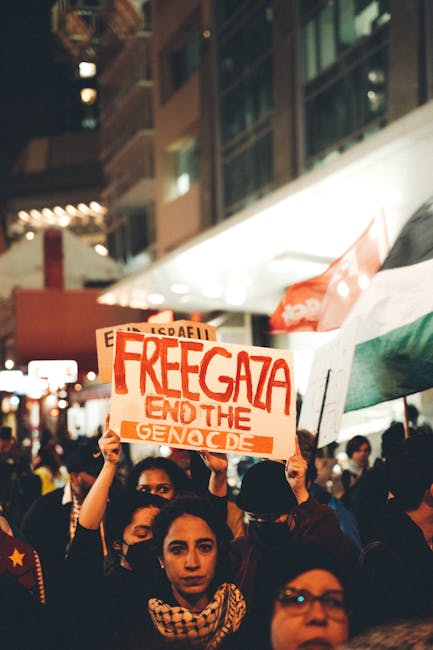Gaza Strip News: A Comprehensive Overview of Current Events, Humanitarian Crises, and Political Conflicts
Understanding the Complexities of Gaza
The Gaza Strip, a self-governing Palestinian territory bordering Egypt and Israel, is a region mired in complex political, social, and humanitarian challenges. News from Gaza often focuses on the ongoing conflict with Israel, the humanitarian crisis stemming from blockades and limited resources, and the internal political divisions within the Palestinian territories. This article provides a comprehensive overview of recent events, key players, and the underlying factors driving the situation in Gaza.
The Israeli-Palestinian Conflict: A Long History of Tension
The conflict between Israel and Palestine has deep historical roots, dating back to the late 19th and early 20th centuries. The establishment of the State of Israel in 1948 led to displacement and conflict, and the subsequent decades have seen numerous wars and intifadas, including the First Intifada (1987-1993) and the Second Intifada (2000-2005). The Gaza Strip has been a focal point of these conflicts, enduring multiple military operations and prolonged sieges.
Key Events Shaping Gaza News
- Operation Cast Lead (2008-2009): A large-scale Israeli military operation in Gaza resulted in significant civilian casualties and widespread destruction.
- Operation Pillar of Defense (2012): Another Israeli military operation triggered by rocket attacks from Gaza.
- Operation Protective Edge (2014): A major conflict characterized by intense fighting and a high number of casualties on both sides.
- Ongoing Border Protests (2018-Present): Mass protests along the Gaza-Israel border, often involving clashes with Israeli forces and resulting in numerous injuries and deaths.
- Recent Ceasefires and Tensions: While ceasefires have periodically been implemented, tensions frequently escalate, leading to renewed outbreaks of violence.
The Humanitarian Crisis in Gaza
The ongoing conflict and blockade have created a severe humanitarian crisis in Gaza. The blockade, imposed by Israel and Egypt, restricts the movement of goods and people, severely impacting the economy and access to essential resources. This has led to:
- High Unemployment Rates: A significant portion of the Gaza population is unemployed, contributing to widespread poverty.
- Limited Access to Healthcare: The healthcare system in Gaza is severely strained, with limited resources and capacity to meet the needs of the population. Many patients are unable to receive necessary treatment, leading to preventable deaths.
- Water and Sanitation Issues: Gaza faces severe water shortages and sanitation problems, posing serious threats to public health.
- Food Insecurity: Many families struggle to access sufficient food, leading to malnutrition, especially among children.
- Power Shortages: Frequent power outages disrupt daily life and impact essential services.
Political Landscape and Internal Divisions
The Gaza Strip is governed by Hamas, a Palestinian Islamist political organization considered a terrorist group by several countries. This has led to international isolation and sanctions, further exacerbating the humanitarian crisis. The political division between Hamas in Gaza and Fatah in the West Bank also contributes to instability and hinders efforts to achieve a lasting peace.
Key Players in the Gaza Conflict
- Hamas: The ruling political party in Gaza.
- Fatah: The dominant political faction in the West Bank.
- Israel: Controls Gaza’s borders and airspace.
- Egypt: Plays a role in mediating between Hamas and Israel, and controls the Rafah border crossing.
- United Nations: Provides humanitarian assistance and works towards conflict resolution.
International Efforts and Humanitarian Aid
Numerous international organizations, including the United Nations Relief and Works Agency for Palestine Refugees in the Near East (UNRWA), provide essential humanitarian assistance to the people of Gaza. However, the needs far outweigh the available resources, and the long-term sustainability of aid efforts remains a concern. International efforts to mediate a lasting peace between Israel and Palestine continue, but progress has been slow and fraught with challenges.
The Future of Gaza: Challenges and Opportunities
The future of Gaza remains uncertain. Addressing the humanitarian crisis, achieving political reconciliation between Hamas and Fatah, and finding a lasting solution to the Israeli-Palestinian conflict are critical steps towards improving the lives of the people of Gaza. The international community plays a crucial role in supporting these efforts and ensuring that the voices of the Gazan people are heard.
Looking Ahead: Potential Pathways to Peace and Stability
- Easing the Blockade: Allowing increased flow of goods and people would significantly improve the economic and humanitarian situation in Gaza.
- Political Reconciliation: A unified Palestinian government could strengthen the Palestinian negotiating position with Israel.
- International Pressure for Peace: Continued international engagement and pressure on all parties involved are crucial for achieving a lasting peace.
- Investing in Gaza’s Development: Significant investments in infrastructure, education, and economic development are essential for long-term stability and growth.
The situation in Gaza remains dynamic and complex. Staying informed about current events through reliable news sources is crucial for understanding the challenges faced by the people of Gaza and the ongoing efforts towards peace and reconciliation. This overview provides a starting point for understanding this multifaceted conflict and the urgent need for a just and lasting solution.

